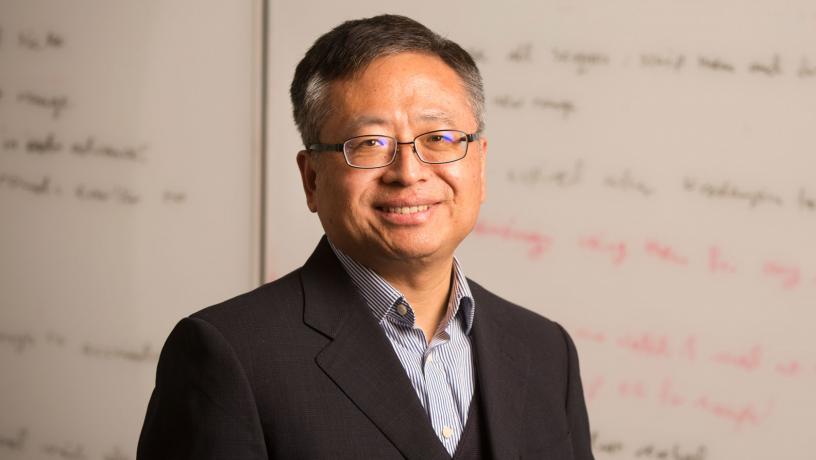Faculty Tech Talk: The Power of Fintech
When it comes to investing, the wealthy have long enjoyed a major advantage: they can afford to pay advisers to build their fortunes, while people with smaller nest eggs often are left to either rely on mutual funds or manage their money themselves.
That dynamic is now changing; thanks to powerful new algorithmic tools capable of helping millions of ordinary investors master the markets. These data-driven innovations are part of a wave of financial technology, or fintech, that are transforming areas like banking, insurance, and investing at a rapid clip—last year, the global total of assets under management by so-called robo-advisors topped $200 billion.
Two Columbia Engineering professors at the forefront of the field recently sat down with Dean Mary C. Boyce and a crowd of students on October 11 to discuss how state of the art technology is slashing costs and incorporating the human element, as part of the School’s latest faculty tech talk.
Garud Iyengar, professor and chair of industrial engineering and operations research, described his work understanding uncertain systems and utilizing control and optimization algorithms to exploit available information. Xunyu Zhou, the Liu Family Professor of Financial Engineering and director of the FDT Center for Intelligent Asset Management, shared his research on quantitative behavioral finance models that incorporate human psychology into decision making and intelligent wealth management.
We’ve excerpted a few edited highlights of the conversation below:

Garud Iyengar

Xunyu Zhou
Q: How has fintech become so effective at minimizing costs?
Garud Iyengar: Technology is contributing to reducing costs in several different ways. First, it is removing costs and time involved in acquiring and verifying information. For example, by maintaining a single distributed ledger and allowing smart contracts, blockchains are contributing to reducing the cost of information verification and better manage the risk in commercial lending. Sensors are allowing insurers to acquire granular information about their clients; allowing them to design personalized information. Another example is the effort by many investment banks to use natural language generation methodology to algorithmically generate investment reports at significantly lower cost—thereby, making it possible for these reports to be available for larger customer base. And third, technology is helping deliver insights that were previously very difficult to obtain. Using natural language processing on electronic health records together with the chemical composition of drugs, we are now in the position to detect and prevent potentially fatal drug interactions.
Xunyu Zhou: One of the essential reasons is that fintech provides automated solutions. Take wealth management for example. Previously, wealth management service was exclusive and expensive because you needed someone specifically working for you to plan and manage your investment. With fintech algorithms (e.g. robo advisors) portfolios are generated automatically and tailor made to individuals (by learning the preferences and behaviors of individuals). There is minimum human involvement and hence the cost is greatly reduced.
Speaking of behaviors, the question is also related to behavioral economics. Neoclassical economics believes that people are rational, that information is complete, that the market is efficient, so in a sense it portrays a utopia. But behavioral economics, which started in the 1980s, has a completely different view that human emotion and psychology will impact decision making so therefore in general people are not really rational and the market is not efficient. There’s an intimate connection between fintech and behavioral economics because behaviors are also a type of data, which is crucial to fintech. Fintech standardizes and automates decision making, thereby sort of minimizing the impact of humans’ flawed decisions and the associated cost.
There’s an intimate connection between fintech and behavioral economics because behaviors are also a type of data.
Q: To do that, fintech incorporates numerous different modalities of data—video, sensors, text, and numbers. How does all this add up to understanding the human element?
Zhou: Warren Buffet does a lot of research, reads a lot of company reports, visits companies, and talks to people to achieve his sort of performance, but in my lab, we believe that all these things, all the information, are somehow hidden in the data. The only thing is that human beings cannot see it. But fintech algorithms can, through learning, pattern recognition, neural networks, etc., in a much faster and more accurate way.
Q: Neither of you started out in engineering financial technology. How did your paths lead you into the field?
Iyengar: My career and orientation was greatly influenced by the fact that I did my PhD in the Information Systems Lab (ISL) in the electrical engineering department at Stanford University, and Tom Cover was my advisor. Tom and ISL gave me the training to design algorithms to extract information in pretty much any context. There is information in noisy financial data, and there are a set of financial products that can be used exploit this information. Posed in this manner, many financial decision problems become giant control problems.
Zhou: My original research was in control, optimal control, and stochastic control; it’s almost by accident that a colleague showed me a finance problem. At that time, I didn’t know anything about finance, but the models and equations behind the problem were essentially the same as those in stochastic control. Technologies that are being used for other areas, you never know, can be readily adapted to solving finance problems. You look at your wealth, you look at the market condition, you adjust it—it’s exactly what we call feedback control, with the equation behind it basically the same as the equation for guiding a missile to hit the target.
Q: Fintech has been evolving very quickly as a field. Have we reached a new critical mass?
Iyengar: Many different developments have contributed to rapid development of fintech. Large amounts of financial data is becoming available. At scale computing is now cheaply accessible via the various cloud computing platforms. Cutting edge machine learning and natural language algorithms are available as R or python packages on these platforms. All the tools are available; what’s limiting one is creativity.
